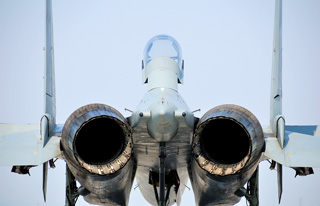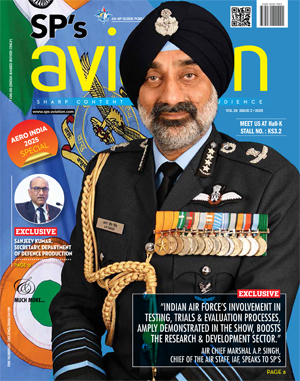INDIAN ARMED FORCES CHIEFS ON OUR RELENTLESS AND FOCUSED PUBLISHING EFFORTS

The insightful articles, inspiring narrations and analytical perspectives presented by the Editorial Team, establish an alluring connect with the reader. My compliments and best wishes to SP Guide Publications.

"Over the past 60 years, the growth of SP Guide Publications has mirrored the rising stature of Indian Navy. Its well-researched and informative magazines on Defence and Aerospace sector have served to shape an educated opinion of our military personnel, policy makers and the public alike. I wish SP's Publication team continued success, fair winds and following seas in all future endeavour!"

Since, its inception in 1964, SP Guide Publications has consistently demonstrated commitment to high-quality journalism in the aerospace and defence sectors, earning a well-deserved reputation as Asia's largest media house in this domain. I wish SP Guide Publications continued success in its pursuit of excellence.
Air Defence - Defending India’s Airspace

The IAF would have to keep working ceaselessly to continue to augment its air defence resources as also pool in all relevant national resources in its quest to fully live up to its air defence responsibilities enshrined in the Union War Book
From the very begining, the Union War Book of India has put the onus of defending the country’s airspace squarely on the shoulders of the Indian Air Force (IAF). But has the IAF been able to discharge its responsibilities in this vital area of India’s defence to the fullest? Resource crunch in the initial stages forced the IAF to adopt a strategy of terminal defences for its vital areas/vital points (VAs/VPs).With passage of time and induction of greater number of sensors, interceptors and surfaceto-air missiles (SAM) systems, the IAF moved up to a limited area defence (LAD) concept in the later part of the last century. However, the present-day threat scenario of beyond visual range (BVR) stand-off weapons, both in the air-to-air and air-to-surface modes, the IAF has little choice but adopt a full-fledged area defence policy. But it is easier said than done, as the defence system also has to ride on a seamless communication network with built-in redundancies to ensure that it cannot be interfered with by the adversary in any meaningful manner.
The IAF built up its air defence network in a laborious brick-bybrick phased manner to cover the high-threat areas first. It created a highly workable ADDC/CRC network on its western border. It also created a Base Air Defence Zone/Centre (BADZ/BADC) for the air defence of its air bases. But this arrangement has given only partial AD capabilities to the IAF with gaping holes remaining in other parts of the country. The problems of obsolescence in the new millennium have further worsened matters for the IAF. Its chain of radars, whether HPR, MPR or LPR/LLTR, are all suffering from excessive use and old age. Its arsenal of Pechora and OSA-AK SAM systems is fast becoming obsolete and need to be replaced expeditiously.
The IAF has indeed taken a holistic approach matched with some concrete steps for an all-round improvement in its AD network. These are summarised below:
- Under a comprehensive modernisation programme, the IAF is going in for a massive revamp of its existing groundbased radar surveillance systems. It is also planning to add four more aerostat systems to greatly enhance its low level capability and suitably cover the western border. But it would have to acquire more such systems to cover other high-threat areas and finally, to cover a major part of the country’s airspace.
- The IAF has already inducted three Phalcon-equipped airborne warning and control (AWACS) systems and in all probability exercising its options to acquire two more. In addition, an indigenous Embraer Emb-145 based airborne early-warning and control (AEW&C) system is being developed for induction into the IAF to complement the AWACS.
- The Su-30 MKI order has been enhanced to 272 aircraft which could equip up to 15 frontline squadrons. A combination of AWACS and AEW&C systems, aerostat radars and Su-30 MKI air dominance fighters could give the IAF the much cherished area defence capabilities at least in selected airspace against aerial threats.
- IAF has ordered 18 Israeli Spyder SAM systems to replace some of its obsolescent Pechora/OSA-AK SAMs. The first batch is reported to have been inducted in March this year. The IAF has also ordered up to eight squadrons worth of the indigenous Akash SAM systems to replace the obsolete SAM IIIs of the Soviet era. In addition, in two separate joint venture programmes, India’s Defence Research and Development Organisation (DRDO) is developing the MICA-based 15-km range Maitri SR-SAM system with France and another 70 km MR-SAM system with Israel. On the ABM front though, the IAF still has a long way to go with the indigenous Prtihvi-based PAD system still to be fielded for full-fledged development. Contrary to information appearing in some website networks, the IAF has not acquired the Russian S-300 system or its derivatives for ABM defence.





